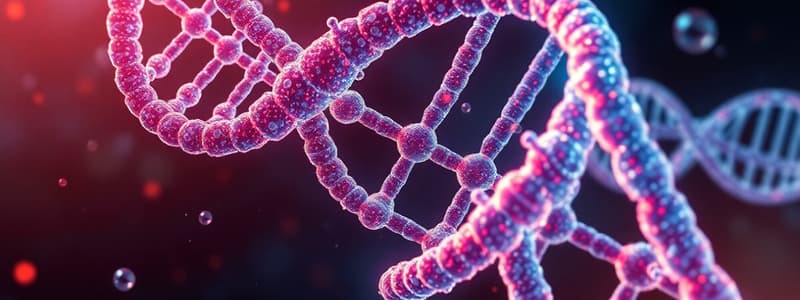Podcast
Questions and Answers
DNA strands can be separated by mechanical force or high temperature.
DNA strands can be separated by mechanical force or high temperature.
True (A)
The formula used to prepare diluted reagents is M1V1 = M2V2.
The formula used to prepare diluted reagents is M1V1 = M2V2.
False (B)
To prepare a 10 mL solution at 15% concentration from a 50% stock solution, 3 mL of stock is required.
To prepare a 10 mL solution at 15% concentration from a 50% stock solution, 3 mL of stock is required.
True (A)
The molecular weight of NaOH is calculated to be 58.
The molecular weight of NaOH is calculated to be 58.
To prepare 250 mL of a 2M TES buffer, 100 mL of a 5M solution is needed.
To prepare 250 mL of a 2M TES buffer, 100 mL of a 5M solution is needed.
DNA carries genetic instructions for the development of all known living organisms and many viruses.
DNA carries genetic instructions for the development of all known living organisms and many viruses.
RNA is composed of nucleotides that contain the sugar deoxyribose.
RNA is composed of nucleotides that contain the sugar deoxyribose.
The nucleotide bases in DNA can be either purines or ketones.
The nucleotide bases in DNA can be either purines or ketones.
Adenine in DNA bonds with thymine through two hydrogen bonds.
Adenine in DNA bonds with thymine through two hydrogen bonds.
Cytosine pairs with uracil in the structure of DNA.
Cytosine pairs with uracil in the structure of DNA.
Nucleotides are connected by covalent bonds called phosphodiester bonds.
Nucleotides are connected by covalent bonds called phosphodiester bonds.
Each type of nucleobase on one DNA strand pairs with more than one type on the opposite strand.
Each type of nucleobase on one DNA strand pairs with more than one type on the opposite strand.
A dinucleotide consists of three connected nucleotides.
A dinucleotide consists of three connected nucleotides.
Flashcards
DNA
DNA
A molecule carrying genetic instructions for living organisms and some viruses.
Nucleotide
Nucleotide
The building block of DNA and RNA, composed of a base, sugar, and phosphate.
Deoxyribose
Deoxyribose
The sugar in DNA.
Ribose
Ribose
Signup and view all the flashcards
Complementary base pairs
Complementary base pairs
Signup and view all the flashcards
Phosphodiester bond
Phosphodiester bond
Signup and view all the flashcards
Purine
Purine
Signup and view all the flashcards
Pyrimidine
Pyrimidine
Signup and view all the flashcards
Dilution formula
Dilution formula
Signup and view all the flashcards
Molarity Formula
Molarity Formula
Signup and view all the flashcards
Dilution of molar solutions
Dilution of molar solutions
Signup and view all the flashcards
Stock solution
Stock solution
Signup and view all the flashcards
Calculating volumes using molarity
Calculating volumes using molarity
Signup and view all the flashcards
Study Notes
DNA Structure
- DNA carries genetic instructions for living organisms and many viruses.
- Some viruses use RNA instead of DNA.
- DNA and RNA are polymeric molecules made of nucleotides.
- Each nucleotide has a nitrogenous base, a five-carbon sugar, and a phosphate group.
- A nucleoside is the base-sugar combination.
- A nucleotide is base-sugar-phosphate.
- DNA nucleotides are deoxyribonucleotides because they contain 2-deoxyribose sugar.
- RNA nucleotides are ribonucleotides because they contain ribose sugar.
- Nucleotide bases are either purines (double-ringed) or pyrimidines (single-ringed).
- Purines in DNA and RNA are adenine (A) and guanine (G).
- Pyrimidine cytosine (C) is found in both DNA and RNA.
- Thymine (T) is a pyrimidine found only in DNA.
- Uracil (U) is a pyrimidine found only in RNA, replacing thymine.
Biochemical Techniques
-
Diluting Reagents: Use C1V1 = C2V2 formula (concentration 1, volume 1 = concentration 2, volume 2).
-
Example: To make 10 mL of 15% fructose solution from 50% stock, use 3 mL of the stock solution and add 7 mL of distilled water to reach the final volume.
-
Calculating Molarity: Formula: Molarity = (Wt / Molecular weight) * 1000 / volume
-
Example: To make 400 mL of 3M NaOH solution: Find the molecular weight of NaOH (23 + 16 + 1 = 40 g/mol) Calculate Wt needed using the above formula : 48 g needed.
Studying That Suits You
Use AI to generate personalized quizzes and flashcards to suit your learning preferences.
Related Documents
Description
This quiz covers the essential concepts of DNA structure, including the components of nucleotides and the differences between DNA and RNA. Additionally, it includes biochemical techniques such as diluting reagents using the C1V1 = C2V2 formula. Test your understanding of these fundamental topics in molecular biology.




